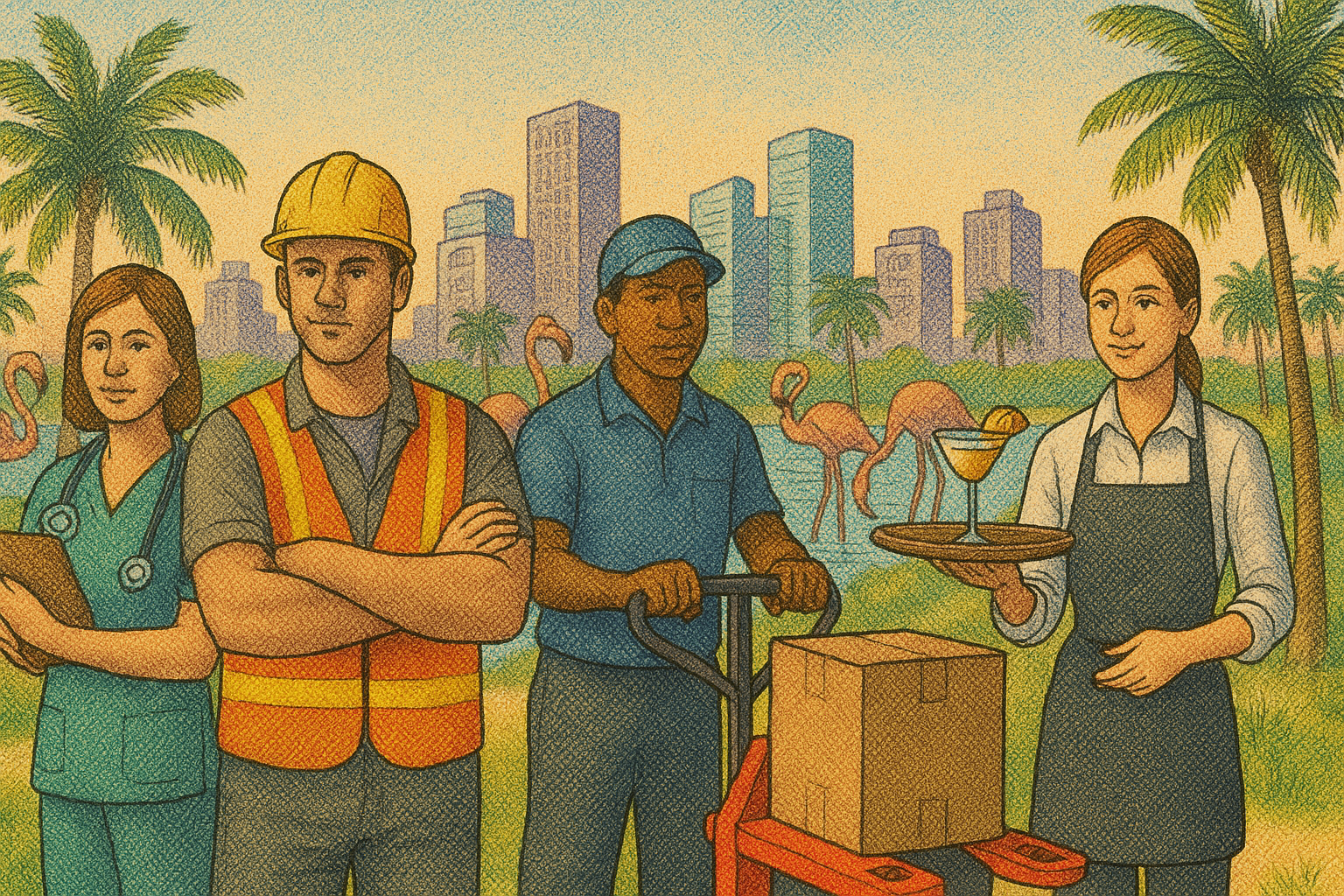The Miami – Fort Lauderdale – West Palm Beach metropolitan economy posted modest employment growth over the past year, even as signs of a broader regional cooldown emerged, according to new data from the Southeast Information Office of the U.S. Bureau of Labor Statistics (BLS).

As of April 2025, total nonfarm employment in the area rose by just 1.1%, adding 33,400 jobs year-over-year. That’s down from previous years and trails the national growth rate of 1.8% over the same period. Still, some sectors, especially healthcare and construction, are bucking the trend and expanding rapidly.
Growth by Metro Division
- Miami-Miami Beach-Kendall (Miami-Dade County) leads growth with 20,900 new jobs, up 1.6% year-over-year.
- Fort Lauderdale-Pompano Beach (Broward) saw a modest 0.9% increase (7,900 jobs).
- West Palm Beach-Boca Raton-Delray Beach (Palm Beach) recorded slower gains of 0.7% (+4,600 jobs), but remains steady.
The standout performer? Education & Health Services accounted for 12,700 new jobs locally, a 2.7% rise, though slightly below the national growth of 3.4%. Palm Beach alone contributed nearly half of those gains. This consistent demand signals sustained need for healthtech, elder care innovation, and workforce training.
Construction followed closely, growing 2.4% with a net gain of 3,800 jobs, anchored by Miami-Dade activity (+7.4% y/y). These gains come as demand for new housing and healthcare infrastructure continues to rise across South Florida, fueled by population growth and migration.
Trade, Transportation & Utilities added 10,400 jobs (+1.6%), with retail trade as the primary contributor (+4,800).
Meanwhile, information sector jobs dropped by 1.6%, the sharpest decline of any sector, while leisure and hospitality employment slipped 0.4%, reflecting challenges in tourism and media amid rising costs and slower consumer spending.

Wages Remain Competitive, But Below National Average!
The average weekly wage in the Miami metro was $1,364 in Q3 2024, slightly below the national average of $1,394. Occupationally, lawyers and nurse practitioners commanded high hourly wages ($78.54 and $63.81, respectively), while roles like retail salespersons and security guards remained near or below $20 per hour.
Compensation costs also remain lower than national averages: in private industry, total compensation per hour worked in the South Atlantic region was $41.19, compared to $44.67 nationally.
Living Costs Rise; Healthcare and Housing Dominate Spending
Consumers in the Miami metro reported average annual expenditures of $71,378 in 2022–2023, just under the U.S. average. But the mix of spending tells a familiar story: housing and healthcare consumed a larger share of household budgets locally than nationally.
Prices for energy in the Miami area fell slightly year-over-year (-5.9%), but food prices rose 2.3% and overall Consumer Price Index (CPI) climbed 2.2%, signaling persistent inflationary pressure in core consumer goods.
Unemployment Stable, But Varies by County
The unemployment rate for the broader Miami area hovered around 2.6% to 3.0%, depending on the county, closely mirroring national trends. Miami-Dade, Broward, and Palm Beach counties all maintained relatively low unemployment, a sign of ongoing labor market strength—even amid slower job creation.
Where We Stand Nationally
Among the 12 largest U.S. metro areas, Miami ranked fourth in absolute job gains, after New York (+96,100), Dallas (+52,100), and Philadelphia (+35,800), outpacing markets like Chicago, Atlanta, and San Francisco.
Key Observations for Tech & Startup Builders
- Healthcare (2.7%) & Construction (2.4%) are driving regional employment, opening doors for startups in healthtech, eldercare, construction tech, and smart infra.
- Trade & logistics, buoyed by retail growth, create opportunities for supply chain software, last-mile delivery, and warehouse automation solutions.
- Miami-Dade‘s outsized share in job creation suggests it’s the innovation “hot zone” for pilot testing or scaling tech interventions.
- The stalled leisure & information sectors may leave gaps for emerging startups addressing experience digitization, remote tourism, or media productivity tools.

You must be logged in to post a comment.